6 Empathy-Building Ways to Celebrate the ‘Year of the Rat’ in Your Classroom
The Lunar New Year (often referred to as Chinese New Year) began on January 25, 2020, and we officially entered the Year of the Rat. People born in this year are said to be kind, empathetic, and clever—just like rats! So now’s a great time to celebrate rats for the unique, intelligent, social, resourceful animals they are.
And rats really do need our voices to help them: Millions of rats are currently suffering in laboratories, being used in painful, pointless experiments. Others are dying in agony stuck to a deadly glue trap. And in the filthy, crowded breeding mills that supply small animals to big-box pet stores, rats are often denied water and adequate veterinary care. There are plenty of easy ways to speak up for rats in your everyday life, but by bringing lessons about rats into your classroom, you can help empower young people to feel empathy for these sensitive animals and take action for them, too.
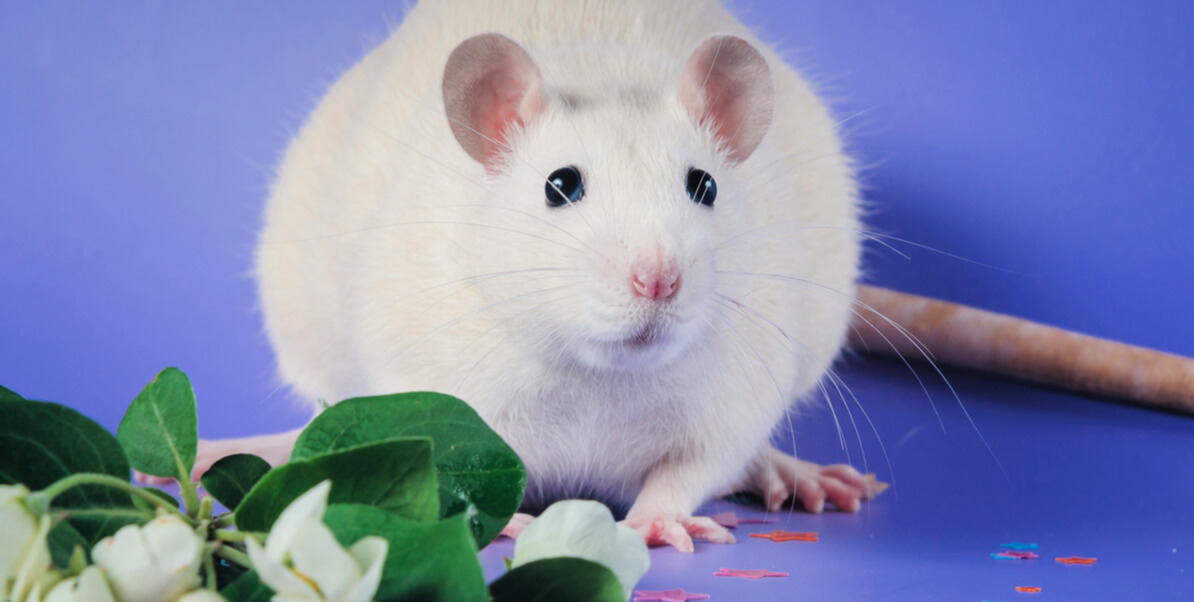
If you’ve already discussed or centered activities around the Lunar New Year in your classroom, any of the following activities can serve as a follow-up. And if you haven’t, you now have the perfect reason to do so!
Check out these six simple ways to celebrate the Year of the Rat in your classroom with a focus on compassion:
1. Discover Amazing Facts About Rats
Rats are sensitive, intelligent, empathetic animals who have the capacity to experience a wide range of emotions. Not only do rats express empathy when another rat (or a human) they know is in distress, they are also willing to help those they don’t know. Researchers found that one rat would save another from suffering even if the suffering one was unfamiliar. These altruistic animals also willingly put themselves in harm’s way to save someone else.
Rats are social and family-oriented. They become emotionally attached to one other, love their families, and bond easily with their human guardians. And they speak to each other in squeaks and high-frequency sounds that are inaudible to the human ear.
If your students are in grades K–5, have them watch the video “Cool Facts About Rats“:
If your students are in grades 6–12, have them watch the video “Rat Facts For Smart People“:
Now read the following excerpt, which is adapted from the PETA article, “The Hidden Lives of Mice and Rats“:
Rats are highly intelligent rodents. They excel at learning and understanding concepts. They’re considerably smaller than dogs but at least as capable of thinking about things and figuring them out. And, while rats are much smaller than elephants, they, too, have excellent memories. Although their eyesight is poor, once rats learn a navigation route, they never forget it.
Rats are also highly social. They become attached to each other, love their own families, and easily bond with their human guardians—giving back as much affection as they get. Many rats even “groom” a human companion’s hand and would appreciate a massage, a scratch behind the ears, or even a tickle in return.
Studies by Jaak Panksepp, a neuroscientist at Bowling Green State University, suggest that when rats play or are playfully tickled, they make chirping sounds that are strikingly similar to human laughter. The rats he studied also bonded socially with the human tickler and even sought to be tickled more. Panksepp corroborates what rat lovers have known all along: “[Y]oung rats have a marvelous sense of fun.”
Male rats like to snuggle up for a cuddle and find contentment when curled up in a human lap. Although female rats are also affectionate, they tend to be tremendously energetic and inquisitive. Most rats love seeing nice people and often bounce around waiting to be noticed and picked up. They can bond with their human companions to such an extent that if they are suddenly separated, they can pine away—and even die.
Did You Know?
-
- Rats are fastidiously clean animals, grooming themselves several times a day. In fact, they are less likely than dogs or cats to catch and transmit parasites or viruses.
- Rats are highly social. They communicate with each other using high-frequency sounds that we can’t hear without special instruments. They play together, wrestle, and love sleeping curled up together. Much like us, if they do not have companionship, they can become lonely, anxious, depressed, and stressed.
- Rats can communicate by touch, smell, or sound at frequencies that we can’t even hear.
- Rats are empathetic. In one ethically compromised study, the vast majority of the rats tested chose to help another rat who was being forced to tread water, even when they were offered a chocolate treat instead.
- Rats can recognize an expression of pain on other rats’ faces and react to it.
- Rats can recognize their names and respond when called.
- If not forced to live in a dirty cage, rats have a very pleasant perfume-like scent.
Now, have students answer the following questions:
- What are some of the ways that rats show their affection for their human guardians?
- What are some of the ways that rats communicate with each other?
- Do rats show empathy toward other individuals? What makes you think so?
- In what ways do you think rats and humans are similar?
2. Teach Students About Rats in Labs Using ‘A Rat’s Life’ Comic Book
TeachKind’s “A Rat’s Life” full-color comic book tells the story of Sunshine, a rat who was rescued from a laboratory. This comic is a wonderful age-appropriate resource for introducing younger students to the ethical issues surrounding the use of animals in experiments, and it also includes lots of fascinating facts about rats. You can order free copies of the comic from TeachKind, print it out, or read it together as a class using the online version.
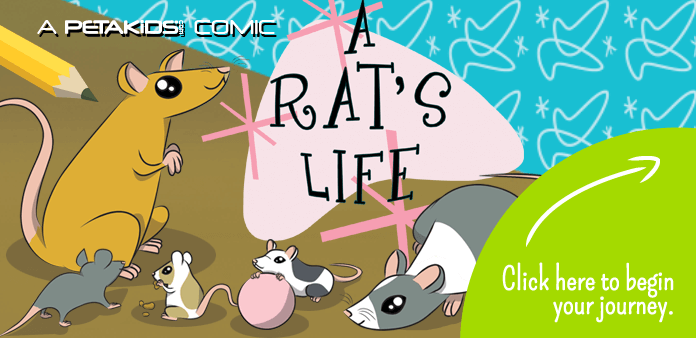
Once students have read the comic, supplement the reading with TeachKind’s corresponding “Amazing Facts” and “Reading Questions” worksheets, which are based on the content in “A Rat’s Life.”
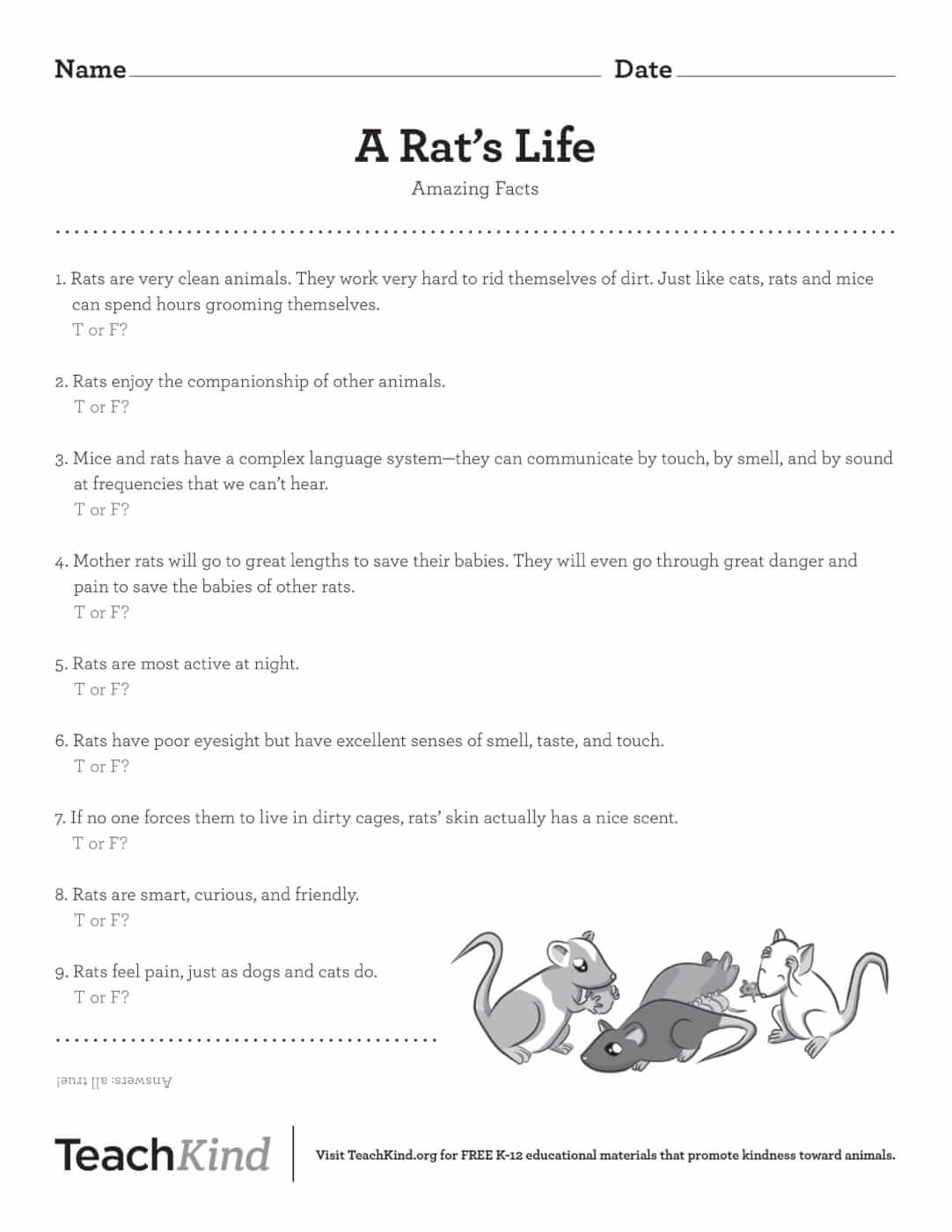
3. Inspire Students With Rat Rescue Story Activities
Rats are intelligent and curious, and they make loyal animal companions for devoted guardians. Sadly, many rats in the pet trade suffer, so it’s important to teach students about proper companion animal care and the importance of adopting animals instead of buying them. TeachKind’s “Rescue Stories: Rescued Rats Find New Home” lesson focuses on the true story of a family of rats rescued from a hoarder by PETA.

Through this lesson, students will learn about the striking similarities between rats and humans as well as ways they can help them. The printable activity sheets that supplement the text of the rescue story feature key vocabulary words and comprehension questions that encourage literal, inferential, and evaluative thinking.
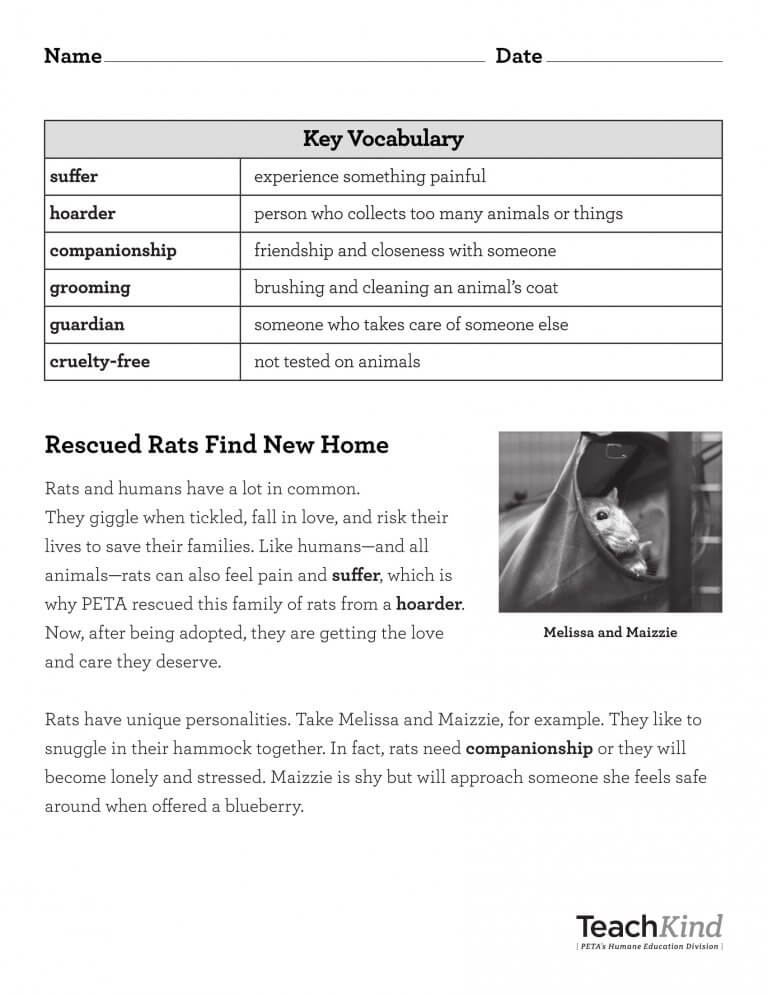
These activities also present a great opportunity to talk to your students about properly caring for a rat and the many factors that must be considered before adopting one as an animal companion—as well as why it’s cruel and inappropriate to keep rats as classroom “pets.”
4. Use TeachKind’s Rat Coloring Sheets
The best way to celebrate rats is to dismantle our ingrained speciesism and start understanding the many ways in which these animals are just like us. Check out TeachKind’s rat coloring sheets (part of the “We’re All Animals” coloring sheet series), which remind us that all animals—including rats—have unique and amazing abilities and qualities and are deserving of our respect and consideration.
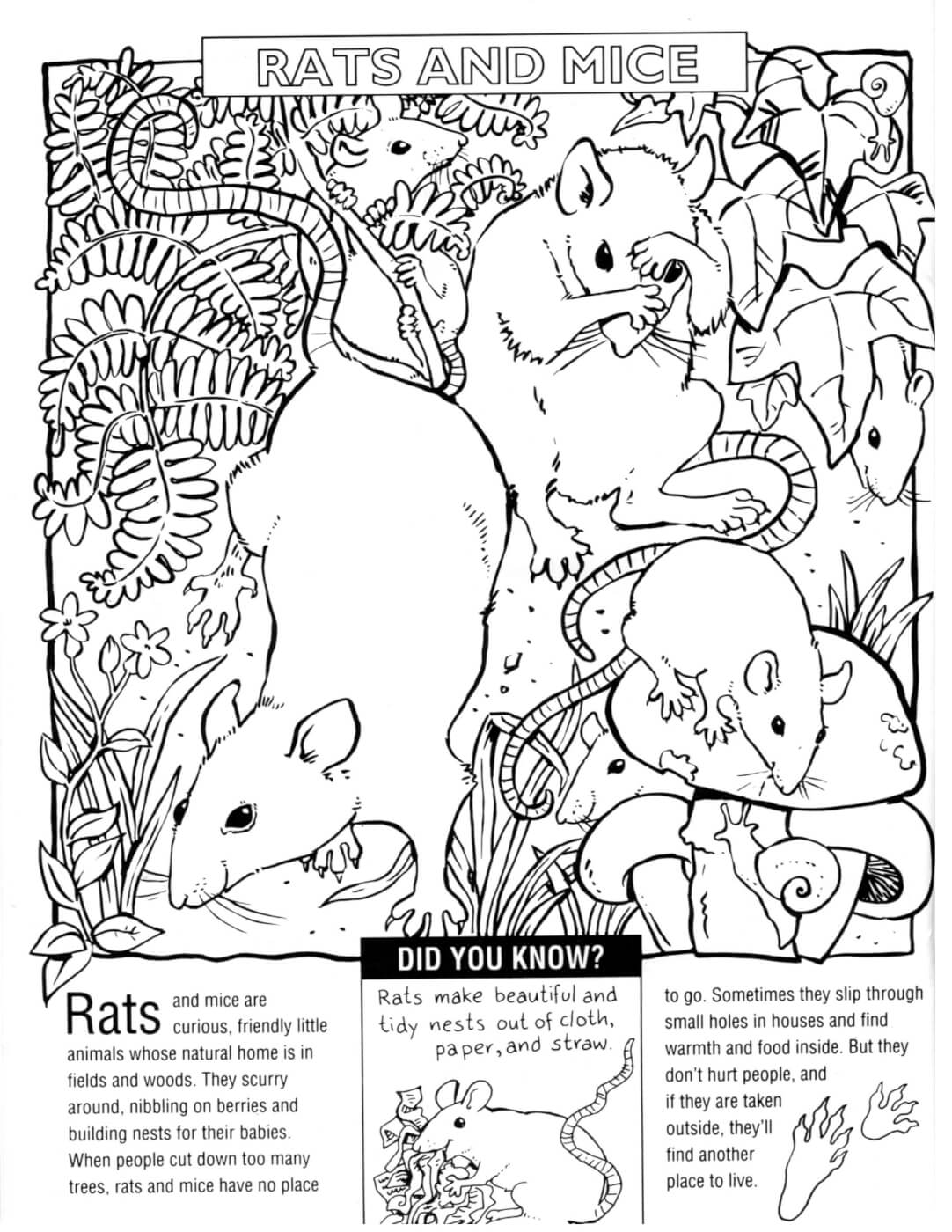
5. Show Students the Importance of Helping Rats in Labs By Buying Exclusively Cruelty-Free Products
Every year, millions of rats are killed in painful, terrifying experiments in laboratories in the U.S. In these tests, they are poisoned, burned, shocked, and more—usually without any painkillers. Empower your students to make a difference by learning to identify and shop for cruelty-free products, which weren’t tested on animals.

Use resources from TeachKind’s debate kit on animal experiments to provide students with background information on the ethics of animal testing. Then, use TeachKind’s “Making Kind Choices: Animal Testing” activity to teach students about the reality of life for rats in laboratories as well as ways they can choose cruelty-free products and take a stand against cruel animal experiments in 2020.
6. Speak Out Against Glue Traps
Glue traps are horrifically inhumane “pest” control devices consisting of a board covered with an extremely sticky adhesive surface that’s designed to ensnare any small animal who steps on it. The unfortunate animals who get stuck face a slow and agonizing death. Often, the traps are even thrown into the trash while the live, suffering animal is still stuck to it. Yet many institutions—including schools and universities—still use these hideous devices instead of keeping rodents away using humane methods.

Thankfully, many places including school districts are making the compassionate choice to ban glue traps, thanks to compassionate students who spoke up for rats, and so are hundreds of other businesses, institutions, and even airports. Find out if your school uses glue traps, and if so, lead the charge against them by creating a petition to your school board asking that glue traps be banned in favor of humane methods, and ask your fellow teachers to sign it. If you find out that a local business is using or selling glue traps, talk to your students about these cruel devices and have them write to the management of the company as a class, asking that it reconsider. E-mail us at [email protected] if you need help or resources!





